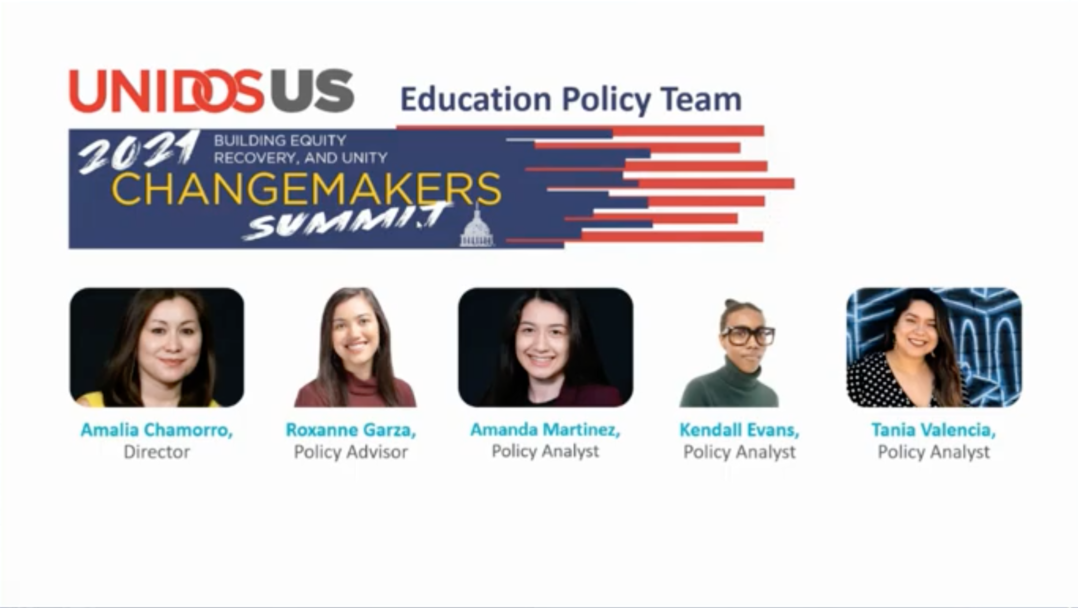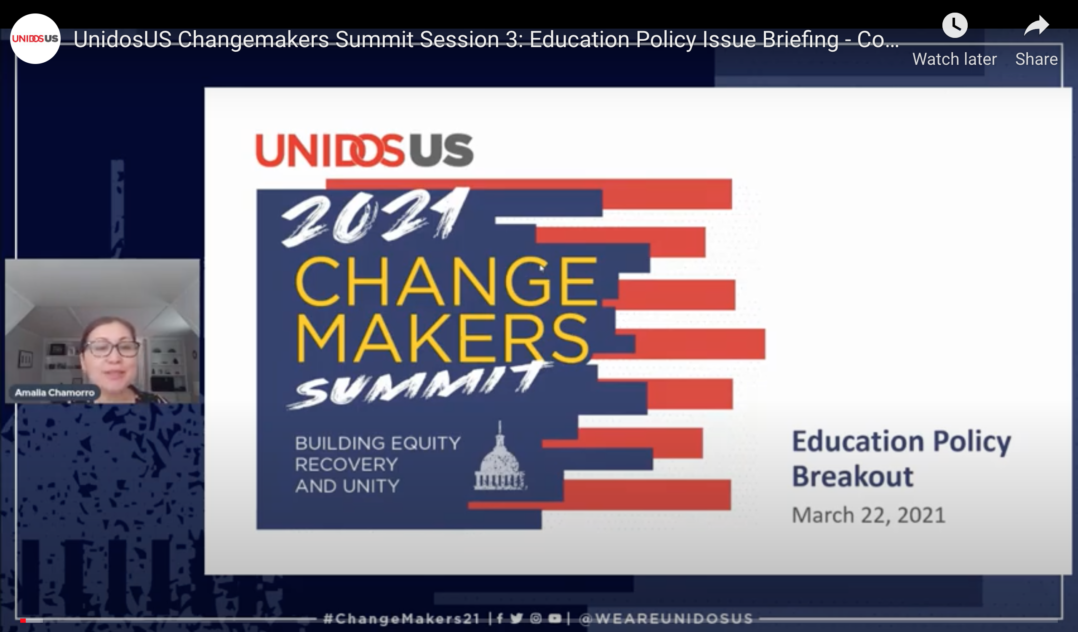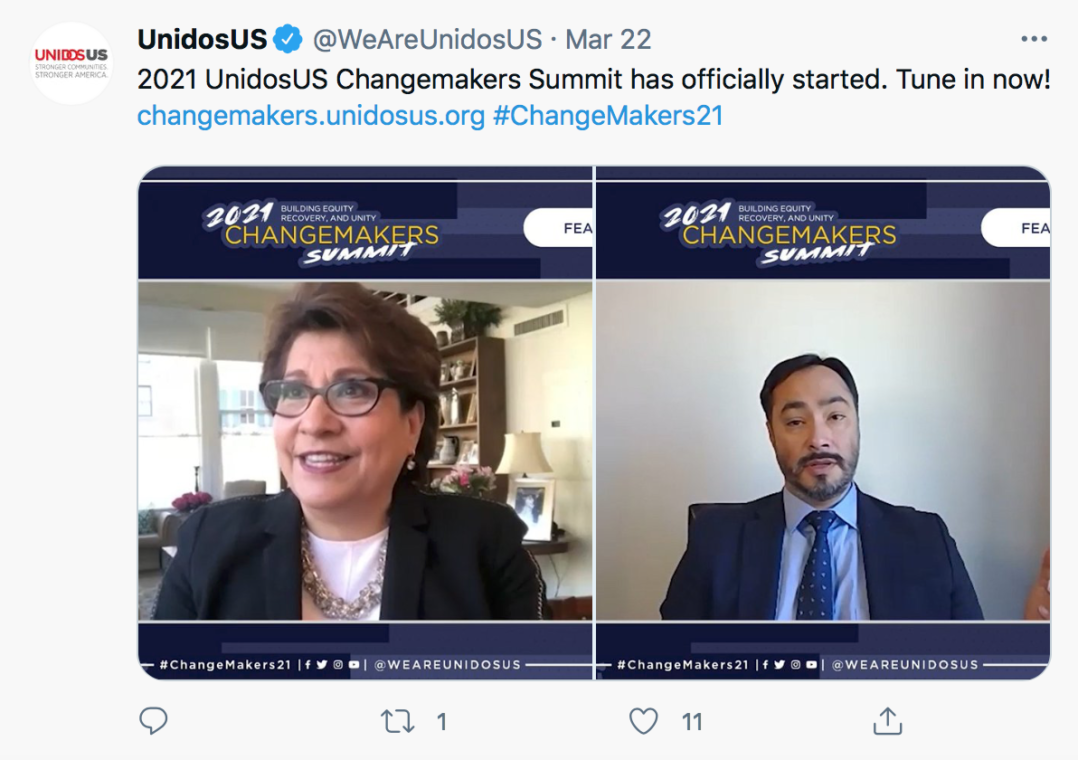Examining Educational Barriers for Latino Children and Youth at the UnidosUS 2021 Changemakers Summit

Over the past year, the pandemic and widespread public outrage over racial discrimination have exposed the deep inequalities and injustices faced by Black, Latino, and other underserved students in the American school system, UnidosUS’s education policy team noted this week during the organization’s 2021 Changemakers Summit.
Every year, the Changemakers Summit brings together activists and leaders from across the nation’s Latino community to inspire and train in civil rights policy and advocacy. While the two-day event has historically taken place in the nation’s capital, and has included meetings with members of Congress, it has been recreating that experience in virtual form during the pandemic.
“It really takes all of us to put in the work and effort to improve conditions for our Latino community and for our students to be able to achieve all of their education dreams,” UnidosUS Education Policy Director Amalia Chamorro said during her opening remarks for the event’s education session.
Keep up with the latest from UnidosUS
Sign up for the weekly UnidosUS Action Network newsletter delivered every Thursday.

Chamorro and a panel of four of her education policy analysts used the event to share key data on the Latino student experience and policy asks that could help to improve that at the early childhood, K-12, and college level. The briefing focused on resources and supports for English learners (ELs), school discipline and emotional learning, culturally responsive workforce development, and supporting underserved students applying to and enrolled in college.
Early Childhood Education
Latinos represent one of the fastest growing demographics in the nation, and that’s especially true among small children. In fact, by 2060, an estimated 32% of children in this age bracket will be Latino, noted UnidosUS Education Policy Analyst Tania Valencia.
One of the programs most likely to serve them is Head Start, a federal program that provides child care, health and nutritional, and educational supports for low-income families with infants and children up to the age of six. In fact, Latino children already make up 37% of its student population. But despite that, Latino children are have some of the lowest enrollment rates in all early childhood education programs.
“We really want to see a reverse of that trend,” Valencia said, noting that UnidosUS wants the federal government to invest $32.1 billion in Head Start to accommodate these concerns.
K-12
UnidosUS’s K-12 education policy explores both traditional public schools as well as public charter schools, some of which are run by community organizations in UnidosUS’s national Affiliate Network.
“We hold the entire system accountable for ensuring student progress and success,” explained Chamorro, adding that it’s going to take a wide range of actors to help students return safely to the classroom and back on track with their learning when the pandemic subsides.
Within that K-12 population, ELs, many of whom are Latino, face some of the biggest educational challenges, and more so during the pandemic. They represent 10% of the U.S. school population, but funding for this population has gone down, and that poses even greater challenges because ELs have experienced significant learning losses during the pandemic. ELs often struggle to adapt their speaking and comprehension skills in a virtual space, and even if they can, their families may lack the technology to help them use interactive online programs.
To relieve these challenges, UnidosUS is asking that the federal government set aside $2 billion in funding for Title III, the part of the federal government’s overarching Every Student Succeeds Act used to help ELs attain English proficiency and meet state standards. The UnidosUS policy team would also like to see an additional $1 billion provided to these students through subsequent COVID-19 relief packages.
And while the obstacles are many, Chamorro commended educators in all public schools for rising to the challenge of teaching and developing new ways of doing so during the pandemic.
“We see you, and part of our work at the federal level is also about supporting our network,” she said. “This is going to be a long recovery phase, and we want to make sure that we’re not only mitigating but getting our students back on track.”
Another area of concern at the K-12 level is the disproportionate discipline and policing of children of color, ELs, and children with disabilities. For example, Valencia noted that Black and Latino boys represent just 3% of the student population but comprise 12% of all arrests, and Black girls are four times more likely to be arrested in schools than White girls.
“This is incredibly important to the Latino community,” said Valencia. “What the data shows us and what we continue to hear is that a lot of Black boys and girls are impacted at larger and harsher degrees of school discipline. And what we know as well is that one in four Latinos in the United States have self-identified as Afro-Latino.”
Meanwhile, children with disabilities are also disciplined more harshly, and ELs are often misidentified as having disabilities because their English speaking and comprehension skills are limited.
“We’re seeing a lot of cross sections here that really need to be elevated,” said Valencia, noting that UnidosUS is supporting the Counseling Not Criminalization in Schools Act, which would prohibit federal funding of police in schools and divert those funds from having a police presence to providing greater school-based mental health services.
Higher Education
In today’s world, it’s difficult to make great join and maintain profitable work in most industries without some form of higher degree, UnidosUS panelists said. Latino enrollment rates had been on a steady increase from 2000 up until the pandemic.
“We’ve seen a 337% increase, which is huge, but one of the big concerns that we have is that Latino students are completing their degrees or their certificates,” said UnidosUS Education Policy Analyst Kendall Evans.
That’s because throughout that same time period, social, economic, and logistical barriers have impeded their ability to pay for and complete those degrees.
The panelists said the government will need to take a holistic approach to funding higher education and holding institutions of higher education accountable for ensuring their graduates have the skills and support they need to obtain good jobs.
As part of the Higher Education Act of 1965, the U.S. government established Pell Grants for low-income students which were aimed at creating a debt-free path to a college education. At that time, it covered almost 100% of tuition and other costs.
“It really opened the doors,” said UnidosUS Education Policy Analyst Amanda Martinez. “Whatever your socioeconomic status you was, it didn’t matter. They wanted to provide a way to support your college pursuits if you wanted to access that.”
But she said the Pell Grant has not been keeping pace with the costs of getting that degree, and now it covers less than 30% of those bills, which is especially problematic at a time of such high unemployment. As such, many students are accumulating crippling debt, and when they can’t pay for it, it can have dire consequences for their ability to become a homeowner or even re-enroll in school.
UnidosUS would like to see more money put into the Pell Grant, but at the same time, its education team is supporting the cancellation of at least 10% in loan debt to accommodate for the struggles students workers are facing during the pandemic.
“We’re worried that without any further action, the economic and educational inequalities in the nation is going to widen for Latinos, so we really need to do everything we can to get students the comfort they need to enroll or re-enroll, said UnidosUS Education Policy Advisor Roxanne Garza.
She noted that the pandemic has led to a decline in first-generation Latino enrollment and that the idea of the “traditional” student is fading. That is, about 70% of Latino students are the first in their families to go to college, their average age is 25, and they are likely working full or part time as they study.
So the challenge isn’t just economic. Low-income and first-generation students may not have the same intergenerational knowledge of how to get to, pay for, keep up with, and graduate from college as more affluent students. In fact, that’s why the U.S. government developed a federal program called Gaining Early Awareness and Readiness for Undergraduate Programs (GEAR UP).
Martinez says “scaling up” the cultural competency of GEAR UP to serve the increasing Latino student population is one key way to provide that support. At the time, she said the federal government should also be holding institutions of higher education accountable for providing like-minded services.
“We want to make sure Congress is thinking about ways that institutions are doing as much as they can within their resources to provide students with the financial and academic support programs they need to help their specific population,” said Martinez, adding that the government should also be “measuring and monitoring what outcomes the institutions are producing. Are they producing gainful employment for every single one of their students despite their socio-economic status, despite their racial and ethnic background? We want to ensure that those checks are in place.”
And finally, support at the college level can have an impact on students at any level, especially when higher education provides the incentives and supports that diverse students need to become public school teachers and then stay in that profession, which is largely underpaid.
Martinez noted that students of all ages and backgrounds learn better when they are educated by a diverse faculty. The government and the institutions of higher education themselves should work harder to promote that scenario by making studies in education culturally relevant and affordable. By doing so, there is a much better chance of diverse college graduates staying in the teaching workforce.

Given the long-term educational impact of the pandemic, that could be key to helping Latino students recover and ultimately thrive.
“We’re going to have to make up some ground with some of these students who have been impacted,” UnidosUS President and CEO Janet Murguía told Congressman Joaquín Castro during another Changemakers session.
Castro, a House Democrat representing Texas, one of the states with the highest concentrations of Latino students and ELs, agreed. He noted that the last relief bill sought to address the most immediate educational issues. Passed in early March, the $1.9 trillion package earmarked $170 billion for K-12 schools and higher education.
“We have a lot of funding in last package for schools because they’re going to have to do a lot of remediation, intervention, assessing our students, not in a punitive way but in a way that’s helping to remediate them as necessary,” Castro said.

